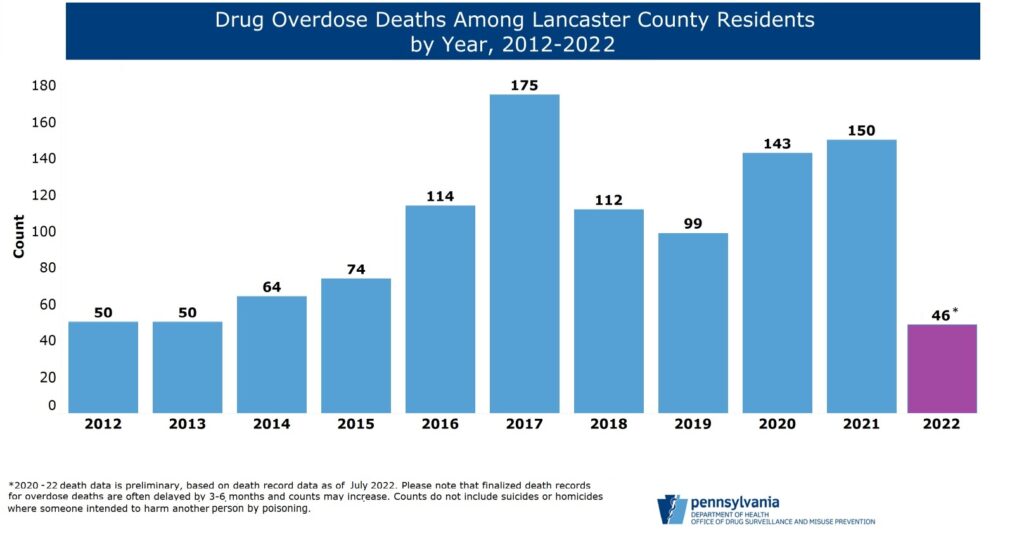The Lancaster County commissioners appear to be broadly on the same page regarding how to spend the county’s initial allotment of funding from the nationwide opioid settlement.
The county is expecting to receive about $16 million over the next 18 years from the settlement, which is to be spent on combating the opioid addiction crisis. Of that, an initial payment of $644,846 is expected “within the next week,” Solicitor Jackie Pfursich said.
Eligible uses include prevention, treatment and support of law enforcement.
Commissioner Josh Parsons co-chairs Joining Forces, a coalition formed in 2017 to coordinate nonprofit and county responses to the opioid epidemic and share best practices. He, fellow co-chair Alice Yoder of Penn Medicine Lancaster General Health and other county and nonprofit stakeholders formed a work group that met over the summer to discuss how best to use the settlement funding.
So far, no set schedule of disbursements has been established, which makes planning difficult, Parsons said. Still, assuming a rough yearly allowance of $900,000, the work group came up with the following preliminary recommendations:
$60,000: Hire a caseworker dedicated to working with parents and infants affected by neonatal abstinence syndrome, a term denoting the withdrawal symptoms experienced by newborns exposed to drugs while in the womb. Local cases of neonatal abstinence syndrome are increasing rapidly, with more than 150 projected this year, Chief Clerk Larry George said.
$140,000: Hire two more assessors for the countywide Student Assistance Program. Similar to employers’ Employee Assistance Programs, the Student Assistance Program provides voluntary assessments and treatment referrals to middle-school and high-school students struggling with mental health or addiction issues. The county has five assessors with master’s degrees available to handle more than 1,000 assessments a year; adding two more would ease their caseloads and “take some of the pressure off,” said Rick Kastner, director of the county Drug & Alcohol Commission.
$300,000: Provide support for Pathways to Recovery, the county’s revamped diversion program for low-level drug offenders. Offenders who complete treatment programs and comply with other requirements can have their charges expunged.
$275,000: Provide support for the county Drug Task Force. Having a dedicated funding stream for the next 15 years or so would contribute toward putting the task force on a “stable trajectory,” Parsons said. He praised District Attorney Heather Adams for restoring integrity and transparency to the task force after a recent scandal involving the alleged embezzlement of more than $200,000.
$125,000: Launch a Medication Assisted Treatment program, or MAT, at the county prison. MAT uses maintenance drugs to reduce withdrawal systems. Combined with counseling and therapy, it can help individuals successfully overcome drug dependence. The prison and PrimeCare Medical, its medical services provider, were in the process of developing a MAT program when the pandemic struck, Warden Cheryl Steberger said. Drug addiction is one of the most complex and time-consuming issues the prison deals with and the problem is worsening, she said: The number of new admissions requiring detoxification services is up 31%.
Parsons described the work group’s proposals as a “rough guideline.” Once the county has its initial allocation in hand, the commissioners can use it as a starting point for discussion.
Commissioner John Trescot said that generally he’d rather see the funding go toward new initiatives than existing ones. He and his colleagues agreed the county should look at programs over multi-year time frames, even if they end up having to vote on allocations yearly due to the uncertainty around when the payments will come in.
Commissioner Ray D’Agostino noted it might be prudent to hold some of the funding in reserve in case a new need or a promising new program emerges.
Tuesday’s discussion was a preliminary one. The commissioners will likely have a follow-up discussion in September, then vote on an allocation, D’Agostino said.
Lancaster County had some success in bringing down opioid overdose deaths from their 2017 peak of 175, but overdoses climbed anew in 2020 and 2021. Experts blame the social isolation caused by the pandemic and the impediments it created for treatment, Yoder said.
So far in 2022, the trend appears to have turned downward again, with 46 overdose deaths reported as of July 18.







